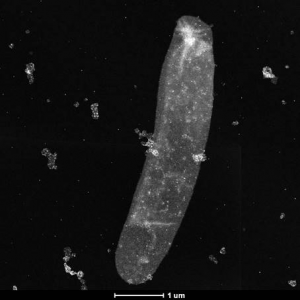|
Uranium is the heaviest naturally occurring element and has two abundant isotopes: 238U and 235U. Large variations in the 238U/235U ratio have been reported in rock and sediment samples collected from a wide range of low-temperature environments. The largest isotope ratio differences were observed between oxidized and reduced depositional environments, suggesting that redox transitions between highly soluble hexavalent uranium (U(VI)) and less soluble tetravalent uranium (U(IV)) may cause isotope fractionation. Thus, 238U/235U ratios have been used as a proxy to evaluate paleoredox conditions in a variety of paleo-environments. Additionally, U isotope signatures have been employed as a tool to monitor bioremediation of uranium at contaminated sites (mining, milling and processing of uranium); a process that relies on the stimulation of indigenous metal-reducing bacteria to precipitate soluble U(VI) as insoluble U(IV), thus removing it from groundwaters. Associated with these U(VI) to U(IV) redox transitions, heavy 238U preferentially accumulates in the reduced U(IV)-bearing phases under equilibrium reaction conditions. However, isotope signatures have shown to be dependent on the reaction mechanism in both abiotic (e.g., via reduced Fe-bearing minerals) and biotic reactions (e.g., via U(VI)-reducing bacteria). Therefore, a thorough understanding of the mechanisms driving U fractionation is of critical importance to improve the reliability of reconstructions of modern and ancient U isotope cycling on the Earth. Our research focuses on underpinning the molecular mechanisms of biotic and abiotic U(VI) reduction and on the factors which control the direction and magnitude of isotopic fractionation. Today, our recent findings support the occurrence of pentavalent U (U(V)) in both biotic and abiotic reduction systems, upon reduction of U(VI) by a one-electron transfer from the mineral or the bacteria. However, questions remain regarding the electron transfer pathway from U(V) to U(IV) in bacterial systems, alongside the isotope signature of the U(V) and its role in the overall uranium isotope fractionation phenomenon. Our research tackles these questions and further explores the impact of biogeochemical conditions. In particular, we seek to characterize the molecular interactions between U(VI) and the outer-membrane proteins of our model microorganism, Shewanella oneidensis MR-1, and to study the impact of the speciation of both U(VI) and the reduced products on the attendant isotope signatures. Further understanding of U reduction mechanisms and its isotope fractionation behavior would significantly improve our monitoring and interpretation of U biogeochemistry, not only in modern redox processes, but also in paleoredox studies.
People: Ashley Brown and Zezhen Pan (Post-docs) and Margaux Molinas (Ph.D. student) |
